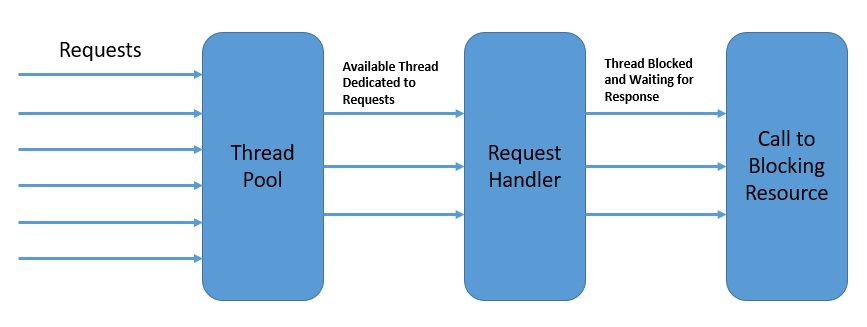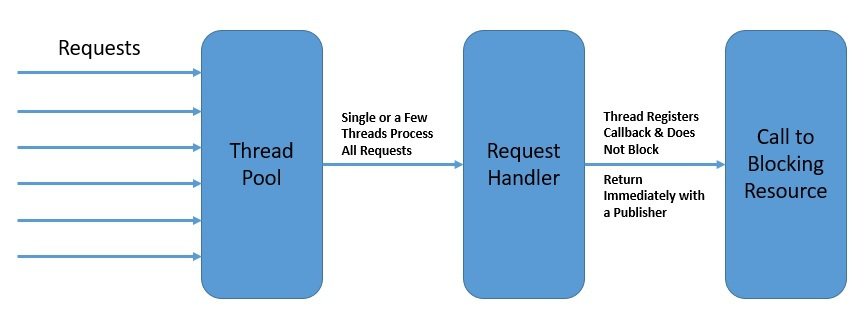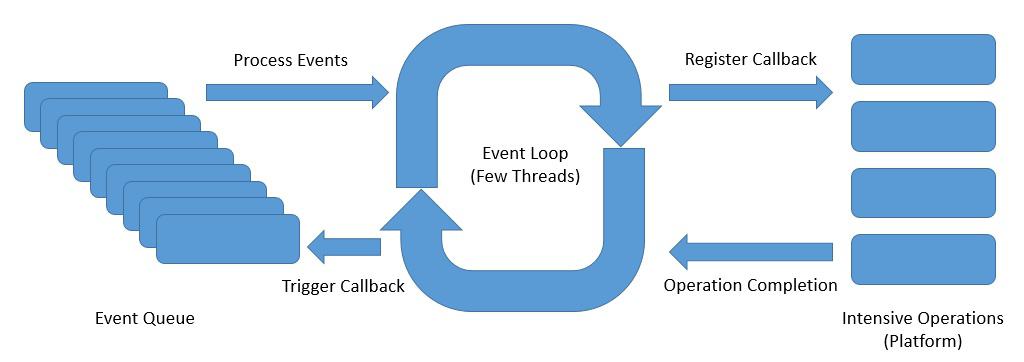1. Introduction
In this tutorial, we’ll explore concurrency in reactive programs written with Spring WebFlux.
We’ll begin by discussing concurrency in relation to reactive programming. After that, we’ll explore how Spring WebFlux offers concurrency abstractions over different reactive server libraries.
2. The Motivation for Reactive Programming
A typical web application comprises of several complex, interacting parts. Many of these interactions are blocking in nature like, for example, those involving a database call to fetch or update data. Several others, however, are independent and can be performed concurrently, possibly in parallel.
For instance, two user requests to a web server can be handled by different threads. On a multi-core platform, this has an obvious benefit in terms of the overall response time. Hence, **this model of concurrency is known as the thread-per-request model**:
 In the diagram above, each thread handles a single request at a time.
In the diagram above, each thread handles a single request at a time.
While thread-based concurrency solves a part of the problem for us, it does nothing to address the fact that most of our interactions within a single thread are still blocking. Moreover, the native threads we use to achieve concurrency in Java come at a significant cost in terms of context switches.
Meanwhile, as web applications face more and more requests, the thread-per-request model starts to fall short of expectations.
Consequently, what we need is a concurrency model which can help us handle increasingly more requests with relatively less number of threads. This is one of the primary motivations for adopting reactive programing.
3. Concurrency in Reactive Programming
Reactive programming helps us structure the program in terms of data flows and the propagation of change through them. Hence, in a completely non-blocking environment, this can enable us to achieve higher concurrency with better resource utilization.
However, is reactive programming a complete departure from thread-based concurrency? While this is a strong statement to make, reactive programming certainly has a very different approach to the usage of threads to achieve concurrency. So, the fundamental difference that reactive programming brings on is asynchronicity.
In other words, the program flow transforms from a sequence of synchronous operations, into an asynchronous stream of events.
For instance, under the reactive model, a read call to the database does not block the calling thread while data is fetched. The call immediately returns a publisher that others can subscribe to. The subscriber can process the event after it occurs and may even further generate events itself:
 Above all, reactive programming does not emphasize on which thread events should be generated and consumed. Emphasis is, rather, on structuring the program as an asynchronous event stream.
Above all, reactive programming does not emphasize on which thread events should be generated and consumed. Emphasis is, rather, on structuring the program as an asynchronous event stream.
The publisher and subscriber here do not need to be part of the same thread. This helps us in getting better utilization of available threads and hence higher overall concurrency.
4. Event Loop
There are several programming models that describe a reactive approach to concurrency.
In this section, we’ll examine a few of them to understand how reactive programming achieves higher concurrency with fewer threads.
One of such reactive asynchronous programming model for servers is the event loop model:
#reactive #spring #webflux

